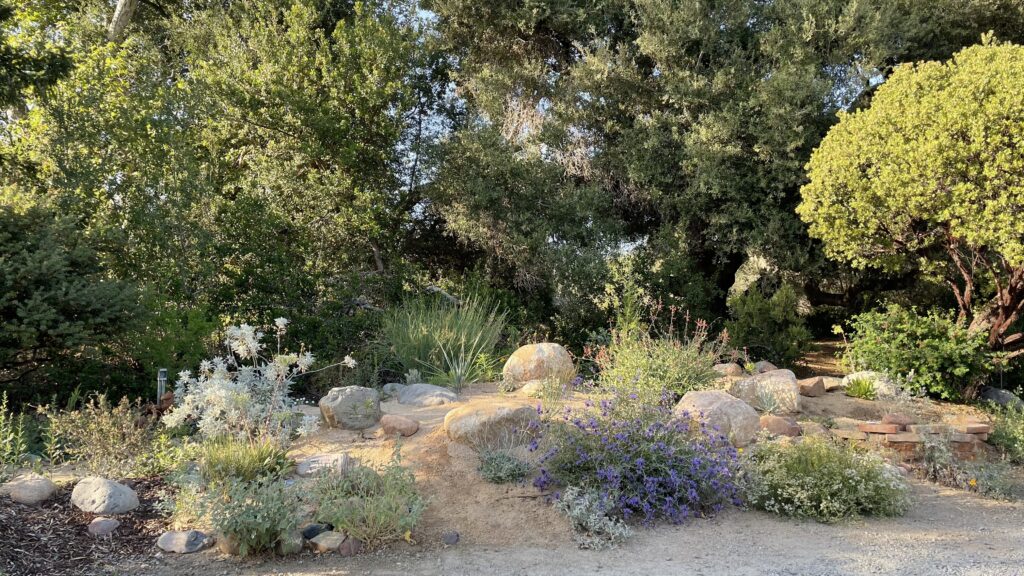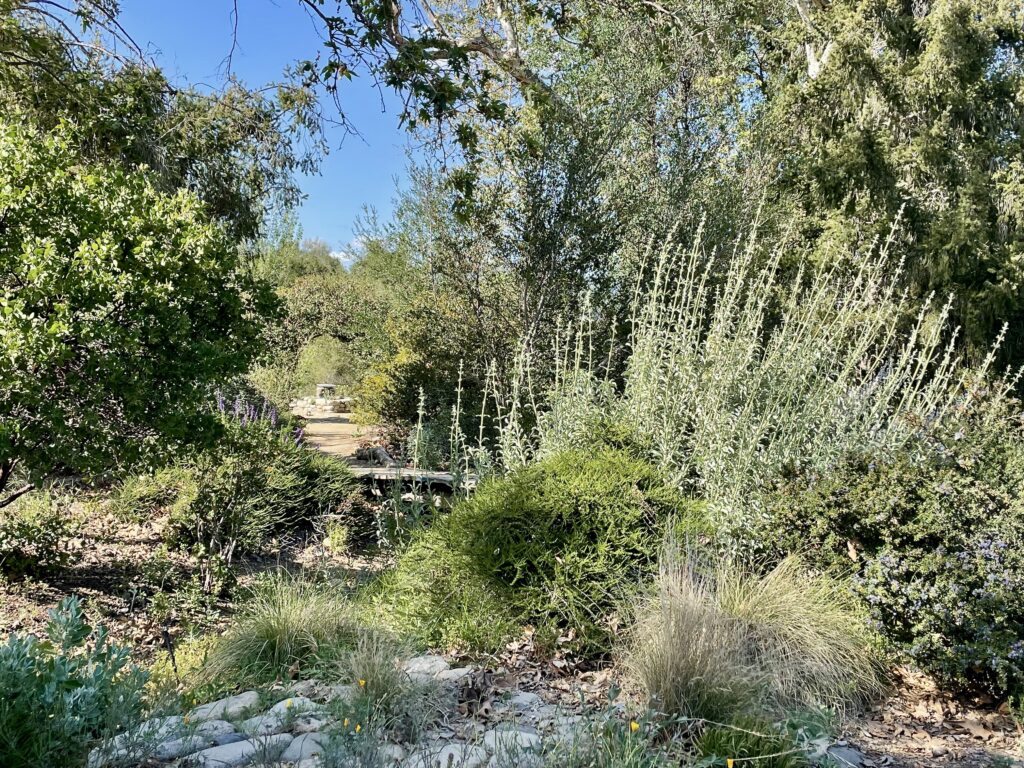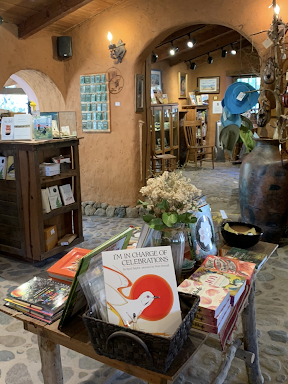May in the Natural Garden
- Posted in: Blog, Monthly Garden Advice
- Tags Garden Maintenance, Seasonal Gardening, Words by Mike Evans

May in the Natural Garden
M is for May, Mothers, Matilija poppy and Maybe one last rain, (but probably not this year).
Forecast: dry with no chance of rain… in fact May marks the month when the chances for more rain start falling away rapidly. In all April, we got less than two tenths inches, bringing our season total to 8”. This is well below “normal,” but even more concerning are the numerous record-breaking heat waves we endured through winter and spring. What little rain came to us got evaporated away and used up by the plants, leaving the soil very dry at the very start of our very official dry season. Natives can handle this scenario better than any other plant in the landscape.

Current events, history, review, and notes
By review, we recognize six seasons in a year’s natural cycles.
Fall – October, November – rains commence, many garden tasks, fall flowers.
Winter – December, January – rain, short cool days, calming dormancy, winter flowers.
Spring – February, March, April – more rain, birds, butterflies, life abounds, abundant flowers.
Pre-Summer – May – farewell cool and moist, hello hot and dry, transition month.
Summer – June, July, August – judicious watering, long hot days, seeds, summer blooms.
Post-Summer – September – farewell hot and dry, hello cool and moist, transition month.
Obviously, we’re in Pre-Summer.

Try again. This Quercus kelloggii, black oak, leafed out in spring only to have its new growth burned off in a heat wave. Leafing out again in May.
Watering
As a reminder, charging the soil with deep moisture now will prove great benefit in August/September. Like managing a bank account, you should make deposits well in advance of withdrawals. A “normal” rainy season would have done this, but since it has been dry and hot, we need to maintain good moisture in the 8-18” soil depth range.
Related to Watering
For at least 45 years the message of “water conservation” has been broadcast loud and clear, at times with great urgency and at other times more casually. Still? Now we’re hearing that gardens can only be watered once a week. What’s the big deal? How about once a month? In summer only. Max five deep soaks a year. Or how about only once or twice a year? Or maybe no supplemental water at all. If you really want to save water, don’t water. Only natives will allow for this.
Pruning
Dead head (trim off spent flowers) on ceanothus. Pinch any plant (tip prune with thumbnail or pruners) to remove the tender new bud from the growing tip of each branch. This will encourage side branching and give you a bushier look. Be careful to not cut off future blooms, only growing tips.
Weeding
With the longer days and warmer soils, summer weeds are showing up in force. Obviously, pulling them when they are small is a lot easier than waiting. Procrastination never works out well in the world of weeding.
Mulching/Top Dress
If your soil is bare and you want a layer of top dress to help you through the summer, this is the last chance to apply it before it gets too hot. See YOUTUBE MULCH video for detailed information. If you have old, tired organic mulch that is matting up because it is made of “sticks, strings, flakes and dust,” get it away from the stems and root zones of your plants or completely off site as soon as possible.
Be on the watch again this year for extreme salt build-up in soils near you because of another year lacking good rain, with no fresh water leaching having taken place. Poor quality mulches will be quite saline after months of improper, shallow irrigation. Salty soil conditions, especially at the surface, predispose plants to warm season root rots and other diseases. You’ll see it all over town this summer, branch die-back and dead plants, but don’t let your plants become victims. Get the bad mulch out of there before it’s too late.
Feeding
If you have not applied an all purpose organic plant food to your garden in spring, this “pre-summer” month is your last chance to promote new growth and sturdy plants before seasonal heat sets in.

Troubleshooting – Varmints, Pests and Diseases
Ants where they don’t belong (i.e.; they belong in Argentina), aphids on new growth (i.e.; salvia), snails everywhere (i.e.; feeding at night)… all the usual subjects. In general, good water management, no excess stringy mulch, occasional Refreshing Sprinkles and proper tip pruning will create a healthy garden environment where pest problems are minimum. Insects and insect eating birds will control mild infestations, and you can treat severe infestations as follows. Ants: Growth regulator baits, or flood their dens. Aphids: Blast them off with a hose, or spray with insecticidal soap. Snails: Hunt them at night, turn off your neighbors daily irrigation, place bowls of stale beer where you see a lot of snails. (Don’t worry, beer goes stale fast in a bowl outdoors).
Annual Wildflowers
Yours should be at their prime, if you sowed seed last fall/winter. Take pictures of your own superbloom.
Adding New Plants
It’s still a great time to put plants in, but only if you will individually water them as needed through summer.

Phytophilia
This month, I’m noticing plants expressing a level of caution. In general no exuberance. Five months of dry heat ahead, scant moisture anywhere, creeks are dry, soil is dry, weather is hot. They’ve seen it before and they know how to get ready.
Important Review
May is Pre-summer
Water to maintain deep soil moisture
Deadheading and tip pruning
Mulch now (if you need it)
Feed now (if you haven’t already)
Create an ecological balance
Love your flowers
Add new plants and water them
Forge ahead… with caution, confident

Engage
The time we spend in the garden, caring for it with elementary tasks, can be summed up in two simple words; experimentation and routine. Sometimes we try something new. But most of our “chores” tend to be the same week to week, or perhaps with longer cycles they stretch from season to season, or year to year. The fact is that farming and gardening include a fair amount of repetitive work.
Since we are working with living plants in our natural gardens, we would do well to turn routine into ritual, thus enhancing our experience for body, mind, soul, and spirit. Within ritual, we can make ceremonies and turn them into our own celebrations. It’s mainly a state of mind.
I like to envision the finished work when I start a project. If my ceanothus needs dead-heading and shaping, I “see” what it will be when I’m finished, work through all the steps to get there and celebrate the result. And who can’t use more celebrations in their lives, especially today? So every May might become for you, a time to perform a “pruning ritual” on your ceanothus. Treat it as a ceremony and upon completion… Celebrate!
The ancients did nothing different. Over many generations, routine tasks performed for basic living became rituals, often with spiritual overtones, and as they were passed on through story and practice, they brought deeper dimension into people’s lives, offering to solidify the connection one to another and to the natural world around them.
It goes well beyond routine. When something new happens… a surprise… that’s even more reason to celebrate! In a simply wonderful children’s book called “I’m In Charge of Celebrations,” author Byrd Baylor depicts a girl who is never lonely in her desert home because…
“I put
myself
in charge.
I choose
my own.
Last year
I gave myself
one hundred and eight
celebrations—
besides the ones
they close schools for.”
The girl goes on to describe how she keeps a notebook for recording each date and special event, so she can celebrate each anniversary.
“I’m very choosy
over
what goes in
that book.”
Things like her sighting of seven dancing dust devils, a triple rainbow, a certain coyote she followed, locking gazes,
“So
on September twenty-eighth
I celebrate
Coyote Day”
or a huge green cloud shaped like a parrot, a meteor shower, and so on. It is a marvelous book, not just for kids, but for us all, because the reader is inspired to also be “in charge of celebrations.”
Make your connection to nature your very own, then share it with others.
Hey, it’s a new season! Let’s start makin’ it! And celebrating!
From the MAY Natural Garden,
Mike Evans
*Byrd Bailor died last year (2021) at the age of 97 years. She lived in southern Arizona (Arivaca), in an adobe house off grid. Byrd authored numerous novels, essays, and children’s books on a manual typewriter. She attended University of Arizona and is related to Robert Baylor, cofounder of Baylor University in Texas.

Questions? Help is just one call or one email away. Call (949) 728-0685 or email (with pictures if you like) our special helpline: gardenhelp@californianativeplants.com